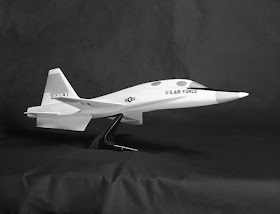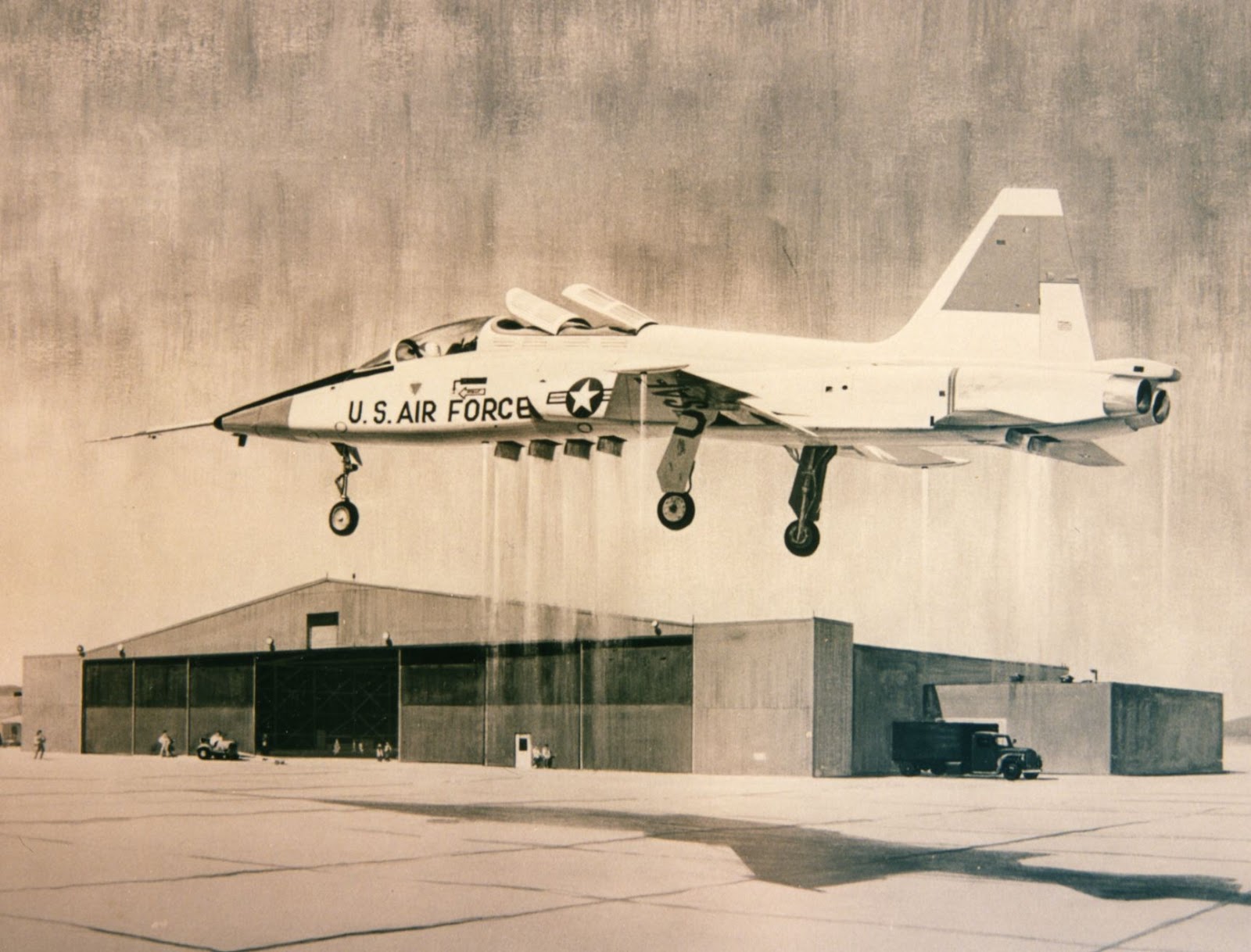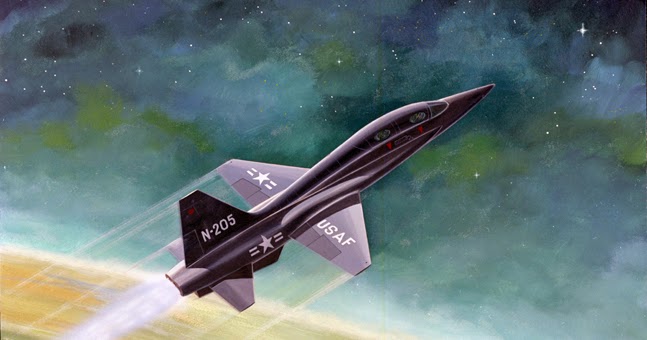Air Marshal Sir Frederick Scherger, RAAF chief in 1957-1961, said in an ANZUS meeting in 1958 that "We are willing to build it (Northrop F-5), we are willing to operate it, and we are very willing to supply it, if we can manufacture it, to the whole SEATO area, if they can afford to buy it and if arrangements can be made for them to get them and use them."
http://www.history.state.gov/historicaldocuments/frus1958-60v16/d19
Minister Casey: Have you come to the end of the military?
Secretary Dulles: I thought we were approaching the end of that.
Minister Casey: I wonder if we would have Air Marshal Scherger have a word on that?
Air Marshal Sir Frederick Scherger:10 Perhaps I should stand to make myself seen and heard, sir.
One of our most pressing problems is to find airplanes with which we can replace our present operation infantry. If we want them and buy them in small numbers, we buy them from the manufacturing country, as we have with transports. We have bought the C–130, as with maritime antisubmarine we have bought the P2V5, and I hope we will have some P2V7. But our real difficulty is with the airplane which is now designed as the technical [tactical?] fighter. The Tactical Air Command here use extremely big airplanes; they are complex, they are sophisticated, and they are tremendously expensive both in cost and in the ground environment you need from which to operate them effectively. Both the airfield’s length and the strength of the airfield is such that in the Southeast Asian theater there are about five airfields from which they can operate. And if you add Admiral Felt’s four carriers, that makes nine. But it still leaves the opponent with a fairly easy problem, and we have been desperately seeking a small, versatile airplane which can range over the whole area and which can operate from the thousand and one 6000-foot strips left over from the last war and which still are there and from which commercial airplanes are still operating.
We believe we have found the airplane in a project which has been raised and was having a little difficulty here, the Northrop–156, which is a development of the T–38 supersonic trainer. It is a light airplane and can have a lot of sophistication in it, but we don’t want a lot of sophistication. We want it in a fairly cheap and uncomplicated form. It is the kind of thing we can build and build relatively cheaply, and it is the kind of airplane which could be used right throughout that area, where we ourselves are perhaps the most capable in the use of modern equipment. But we know that the Filipinos and Thais and the Pakistanis are having more than a little trouble in operating the F–86’s. They can fly them all right, but even they require a fairly good airfield, and their ferry range isn’t all that much. We want an airplane that can go across Australia and from the top end of Australia, across the Philippines, up to Singapore.
I found the philosophy in airplanes here is to build a single-seater airplane which costs over two million dollars a copy, which demands, if you are going to make it mobile, in-air refueling capabilities, which we can’t afford, and which requires an eight-to-eleven thousand foot runway. That kind of airplane is beyond our capabilities.
We find ourselves approaching now the time when it looks as though we are going to be priced out of being able to buy airplanes with which we can suitably arm ourselves. It is a fairly disturbing proposition, sir. And it is one which I thought perhaps, and Mr. Casey agreed, should be aired here, because it is the kind of military problem which I believe ANZUS could solve and I believe should solve. We are willing to build it, we are willing to operate it, and we are very willing to supply it, if we can manufacture it, to the whole SEATO area, if they can afford to buy it and if arrangements can be made for them to get them and use them. That is our problem, sir: How to get the airplane and where to get it—where to get it, rather than how to get it. Europe has nothing. The small NATO fighter which has been proposed to me, the F–91, is just like the Australian boomerang. It is never out of sight. It won’t go far enough. You have these F–105 airplanes, which are over $2,000,000 a copy. Even if we could afford them or build them in sufficient numbers, we couldn’t afford to operate them.
The same applies to the naval tactical fighter, the thing that carries ordinary, or shall I call them conventional bombs. I don’t know why these airplanes are so complex and so sophisticated unless perhaps it is that they are all designed around a nuclear capacity, which of course we don’t possess. We have to base whatever we have on a conventional capacity. I think that is it.
Secretary Dulles: Do you want a reply?
Mr. Irwin: Marshal Scherger brings up a very difficult type of air operation which has been under consideration by the Pentagon for some time in connection with the Northrop F–156 aircraft. I am not completely up to date as to what the current status of the studies are on it, Air Marshal. We had thought of it at one time in connection with NATO and the European countries as well as in the Far East and the Pacific. From the point of view of assisting and financing the manufacture and sale of the planes, the question really revolved around finding a market for it after you had gone all through the expense of development and production in large enough quantities to justify the expense. It was thought at one time that Germany might be interested in the N–156, and possibly Japan. Japan has decided against it and went to Grumman, I believe. Germany also appeared to have rejected it, although I am not sure whether that is completely final or not. So the problem is, if it were available, it is still on the drafting board or has not even been produced in prototype. The question really is, by the time you produce it, is it an adequate airplane for the period of 1961–1962, the period that it is coming in? There is question about it in Europe, and I think there is also considerable question, at least as far as Japan and that part of the Far East area goes.]There is undoubtedly a need for a less-sophisticated aircraft that can meet the problem. Of course, you run into the question, then, as to the control of the air. It would be useless in an area when you are facing a MIG–17 or MIG–19, although obviously you aren’t going to have a big MIG–17 or MIG–19 everywhere you are going to need another airplane. It poses a great problem of financing as well as the tactical application of it. I think the Air Marshal is coming over to the Pentagon tomorrow, I understand.
Air Marshal Sir Fredrick Scherger: That is right; yes.
Ambassador Beale: Mr. Secretary, could I supplement what Air Marshal Scherger said. This is quite a serious problem for Australia.] We have got a first-class aircraft industry in the country. We have a profound political and military necessity for maintaining that aircraft industry in Australia. It is in danger of languishing because we just haven’t got aircraft to make and we can’t plan ahead. A year or two ago we made a decision to buy and probably also to build to sell the F–104, but when a mission came over here,11 we were, I think, very rightly told, “Don’t be silly. Don’t build that one. It is far too sophisticated for you. If that type of aircraft has to be used in a war which you are planning to participate in, we in the United States will be there with that aircraft.” And quite rightly we would have made a great mistake to build the F–104. And we were also told at the same time, ”Why not have a look at the Northrop and one or two others?” This was on the technical level.
The minister in charge of aircraft at the time we were agonizing over this agreed. Now we are told by our air force advisers that this is the type of plane which will suit Australia’s needs. It is not yet, as you say, Mr. Irwin, quite off the drawing board. I think something like one dozen prototypes ought to be made and flown and tested before anybody can say for sure that it is the aircraft. Now what I think the Air Marshal has said is, will the United States give some consideration to making the funds available to take that airplane up to that stage, because if it proves itself I think it is pretty likely, I think it is certain that the Air Force would be advising the Australian Cabinet that “This is the airplane we want and this is the airplane we should build in Australia.” I think New Zealand might become interested in the same sort of aircraft, because it has a characteristic to suit our particular needs. And if we can’t get that one or something very like it, we just have nowhere else to turn for another one to build. We were told to build the Sabres for another year or two or three more. But in the meantime we have a real fight, we have a real professional difficulty in making up our mind as to what type of aircraft it should be.
Mr. Irwin: We have maintained at least to date going ahead on the N–156, trying to resolve this question or problem, but in large measure, it comes down to the financial problem with us, because it is financed by military assistance funds. The question is whether or not if you finance it through the ultimate to have enough prototypes to decide whether it is worth going ahead, are you going to have enough customers to justify the research and development and production of it when you have diminishing military assistance side to keep it up. [sic] They cut the program three hundred million dollars this past year, and we anticipate this next year it will be more difficult.
We have a great many calls on the program throughout the world. We are going to have the situation with Taiwan, and Taiwan has eaten into the program a great deal more than the normal expectancy would have been if there had not been the Taiwan crisis, because equipment had to go to the Chinese Nationalists because of the ammunition situation, etc. So you have a choice of not only do you have a question as to the people that actually would buy this airplane in the time frame of the early 1960’s but you have also the question of priority of the use of the military assistance funds over these few years until there would be production. So it presents a grave complication that the enthusiasm for the airplane itself has to date not been sufficient to justify final decision to go ahead with it.
Minister Casey: So far as the United States is concerned.
Mr. Irwin: The most likely customers had seemed to be Japan and Germany.
Minister Casey: If these aircraft were brought to the prototype stage, isn’t it likely that you would have potential customers in the Asian-SEATO partners in the smaller countries, and it would suit Australia and New Zealand, and there would be more generalized use than your highly-specialized aircraft now.
Mr. Irwin: That seems to be a possibility.
Minister Casey: I think the Air Marshal is seeing Mr. Quarles and Mr. Douglas tomorrow.
Mr. Irwin: I would suggest he also speak to our MAP people.
Minister Casey: I think that is worth raising.
Secretary Dulles: Yes.
[Here follows discussion of unrelated subjects.]



